10 Stunning Terrace Garden Ideas to Transform Your Outdoor Space
1. Vertical Garden Walls
Maximize your limited terrace space by growing upward. Vertical gardens transform blank walls into lush, living tapestries of foliage and flowers. Install pocket planters, modular wall systems, or trellises to support climbing plants like jasmine, ivy, or morning glories. This approach not only adds greenery without sacrificing floor space but also provides natural insulation and sound absorption for your terrace.
2. Container Gardening Arrangements
Create a flexible and visually interesting terrace garden with strategically placed containers. Mix and match pots of various sizes, materials, and heights to add dimension and style. Group containers by plant type or color scheme for maximum impact. Terra cotta, ceramic, concrete, and lightweight fiberglass options all offer unique aesthetic benefits while accommodating everything from ornamental grasses to dwarf fruit trees.
3. Built-In Seating with Integrated Planters
Combine functionality with beauty by installing built-in benches that incorporate planter space. This space-saving solution offers comfortable seating surrounded by your favorite plants. Design L-shaped or U-shaped arrangements to define conversation areas while creating opportunities for layered plantings. Choose weather-resistant materials like cedar, teak, or composite materials for longevity.
4. Water Features and Fountains
Add the soothing sound of water to your terrace garden with a compact fountain or water feature. Self-contained options require minimal installation and maintenance while providing ambiance and attracting birds. Consider wall-mounted fountains, tabletop water gardens, or standalone features scaled to your space. The gentle bubbling sound masks urban noise and creates a more peaceful environment.
5. Outdoor Rugs and Floor Treatments
Define your terrace garden space with weather-resistant outdoor rugs or attractive flooring options. Interlocking deck tiles in wood, stone, or composite materials instantly upgrade concrete surfaces. Outdoor rugs in geometric patterns or nature-inspired designs add color and comfort underfoot. These elements help zone your terrace into distinct areas for dining, lounging, and gardening.
6. String Lights and Ambient Lighting
Extend your terrace garden enjoyment into evening hours with thoughtful lighting. Drape weatherproof string lights overhead to create a magical canopy effect. Add solar-powered path lights, lanterns, or LED candles to illuminate plantings and seating areas. Strategic lighting highlights architectural features and prized plants while making the space usable after sunset.
7. Hanging Gardens and Suspended Planters
Draw the eye upward with hanging baskets and suspended planters filled with cascading flowers and trailing vines. Mount sturdy hooks from pergolas, railings, or overhead structures to support these aerial gardens. Macramé plant hangers add bohemian charm while holding potted specimens at various heights. This technique creates visual interest and frees up valuable floor space.
8. Privacy Screens with Climbing Plants
Create a secluded retreat by combining decorative screens with climbing plants. Lattice panels, bamboo screens, or metal frameworks provide immediate privacy while offering support for fast-growing vines like clematis, honeysuckle, or passion flower. These living walls block unwanted views, filter sunlight, and add natural beauty to your terrace boundaries.
9. Miniature Fruit Trees and Edible Gardens
Grow your own food even in limited terrace space by incorporating dwarf fruit trees and compact vegetable varieties. Columnar apple trees, container blueberries, and espaliered pear trees produce harvests without excessive space requirements. Dedicate sunny corners to herbs, salad greens, and cherry tomatoes in decorative containers for fresh flavors steps from your kitchen.
10. Outdoor Art and Sculptural Elements
Complete your terrace garden with carefully chosen outdoor art pieces that reflect your personal style. Weather-resistant sculptures, wall hangings, or mosaics add personality and focal points among the plantings. Consider wind chimes, kinetic sculptures, or artistic trellises that combine form and function. These decorative elements make your terrace garden truly unique and conversation-worthy.
Creating a Vertical Garden Wall for Small Terraces
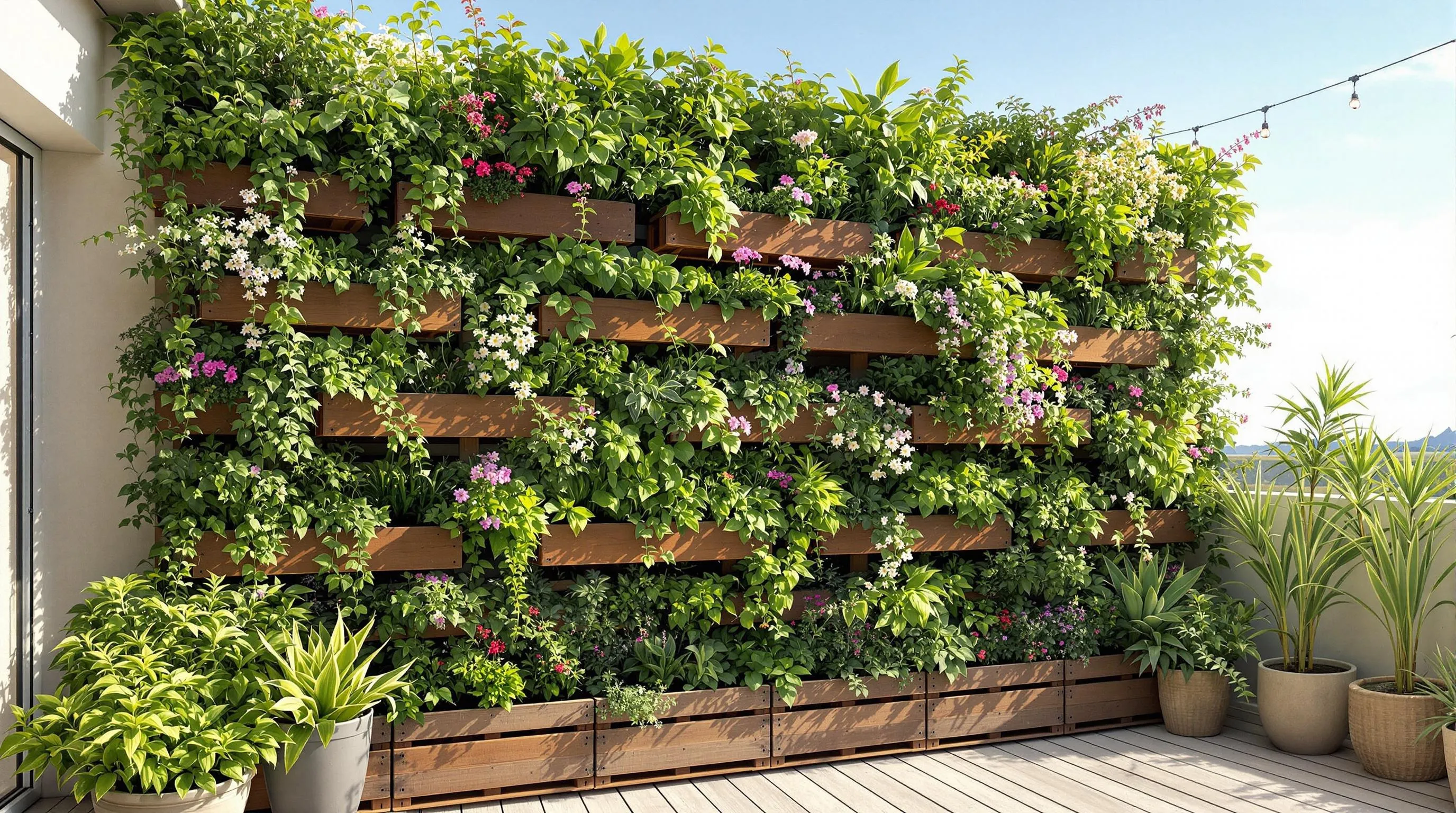
Vertical gardens are the perfect solution for small terraces where floor space is at a premium. By growing upward instead of outward, you’ll maximize your limited square footage while creating a stunning living wall that adds dimension and life to your outdoor area. These space-efficient gardens can transform a plain wall into a lush tapestry of foliage and flowers, providing both beauty and functionality.
Space-Saving Plant Selection for Vertical Gardens
Choose compact plants that thrive in vertical settings to ensure your garden wall flourishes. Succulents like echeveria and sedum require minimal soil and maintenance, making them ideal candidates. Herbs such as thyme, oregano, and mint not only look attractive but provide culinary benefits right at your fingertips. Ferns, spider plants, and pothos offer cascading foliage that creates visual interest. For pops of color, consider trailing petunias, lobelia, or strawberry plants that naturally spill downward. Select plants with similar water and light requirements to simplify care and group them according to their needs for optimal growth in your vertical arrangement.
DIY Vertical Garden Installation Tips
Start your vertical garden project with the right structure—pocket planters, pallets, or specialized vertical garden systems work well for beginners. Ensure your wall can support the weight of plants, soil, and water by installing proper anchoring. Use lightweight, well-draining potting mix to prevent excess weight and water damage. Install a drip irrigation system or position the garden where you can easily reach all plants for watering. Begin with fewer plants than you think you’ll need, as they’ll fill in quickly over time. Place taller plants at the top and trailing varieties at the bottom to create natural flow. Consider installing a waterproof barrier if attaching to your building wall to prevent moisture damage. Finally, establish a regular maintenance schedule to trim, fertilize, and replace plants as needed for a consistently vibrant display.
Incorporating Container Gardening for Flexibility and Style
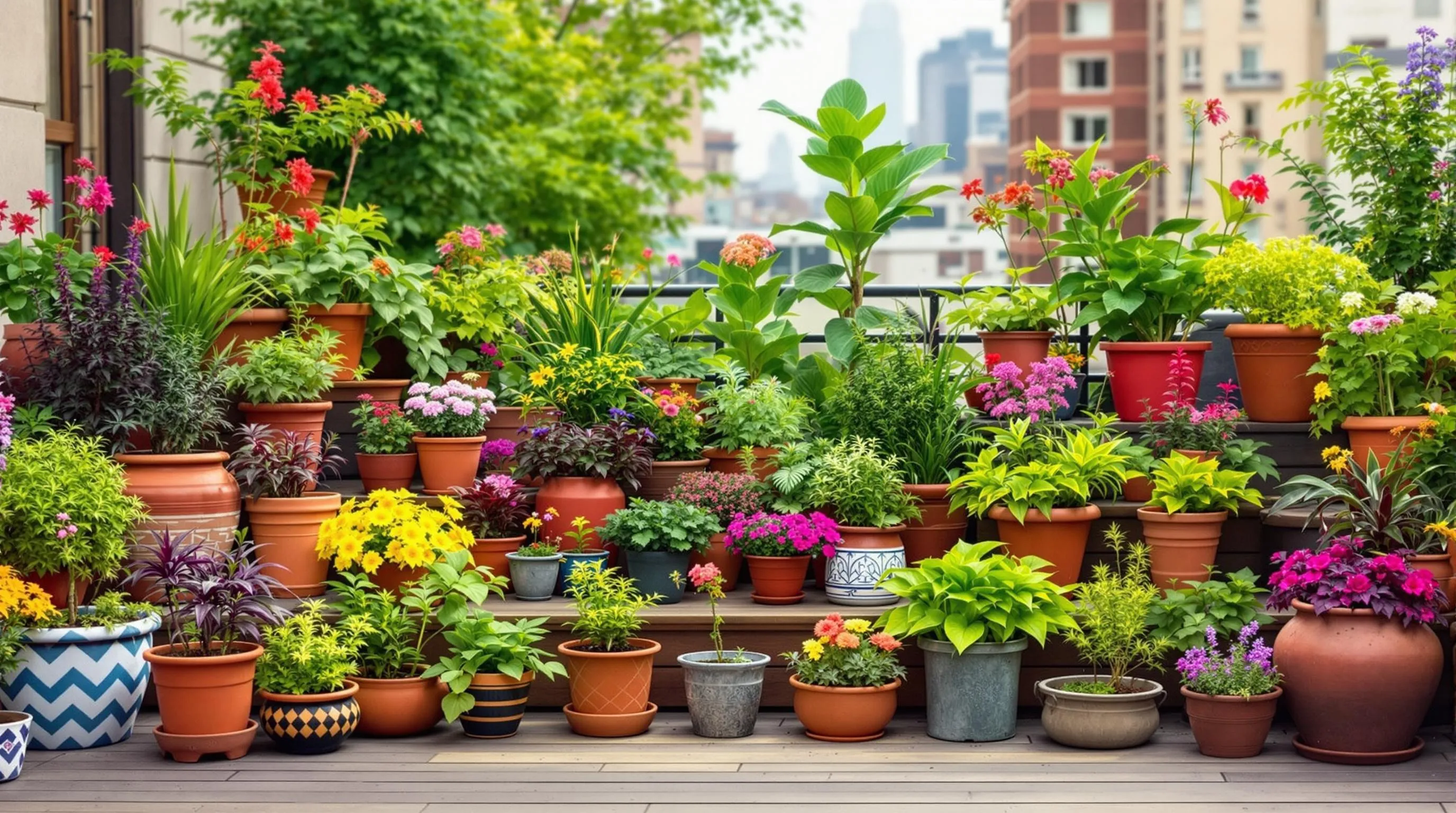
Container gardening offers unmatched versatility for terrace spaces, allowing you to create a customizable garden that can evolve with your needs and preferences. This approach lets you experiment with different plant combinations while maintaining the freedom to rearrange your garden layout as seasons change or inspiration strikes.
Best Container Types for Terrace Gardens
Select containers that balance functionality with aesthetic appeal for your terrace garden. Terracotta pots bring a timeless, rustic charm while providing excellent breathability for plant roots. Lightweight fiberglass planters mimic the look of stone or concrete without the heavy weight, making them perfect for terraces with weight restrictions. Fabric grow bags offer exceptional drainage and aeration while being foldable for off-season storage. Metal containers add industrial flair but require drainage holes and insulation to prevent overheating in summer and freezing in winter. Wooden planters create a natural, organic look that complements most garden styles, though they’ll need weather-resistant treatment. For space efficiency, consider railing planters that attach directly to balustrades or wall-mounted containers that free up valuable floor space.
Strategic Container Placement for Visual Impact
Create depth and dimension by arranging containers at varying heights using plant stands, crates, or tiered shelving. Place taller containers at the back of your terrace and gradually decrease height toward the front for a theater-style effect that showcases each plant. Group containers in odd numbers (3, 5, or 7) to create visually appealing vignettes that draw the eye. Establish focal points with statement containers housing spectacular plants at key viewing locations. Use container placement to define different zones on your terrace, such as dining areas separated from lounging spaces. Incorporate the rule of repetition by using similar containers or plants throughout your terrace to create rhythm and cohesion. Position scented plants near seating areas or entrances where their fragrance can be fully appreciated, and arrange containers to create natural pathways that invite exploration of your terrace garden.
Designing a Cozy Terrace Lounge Area Among Plants
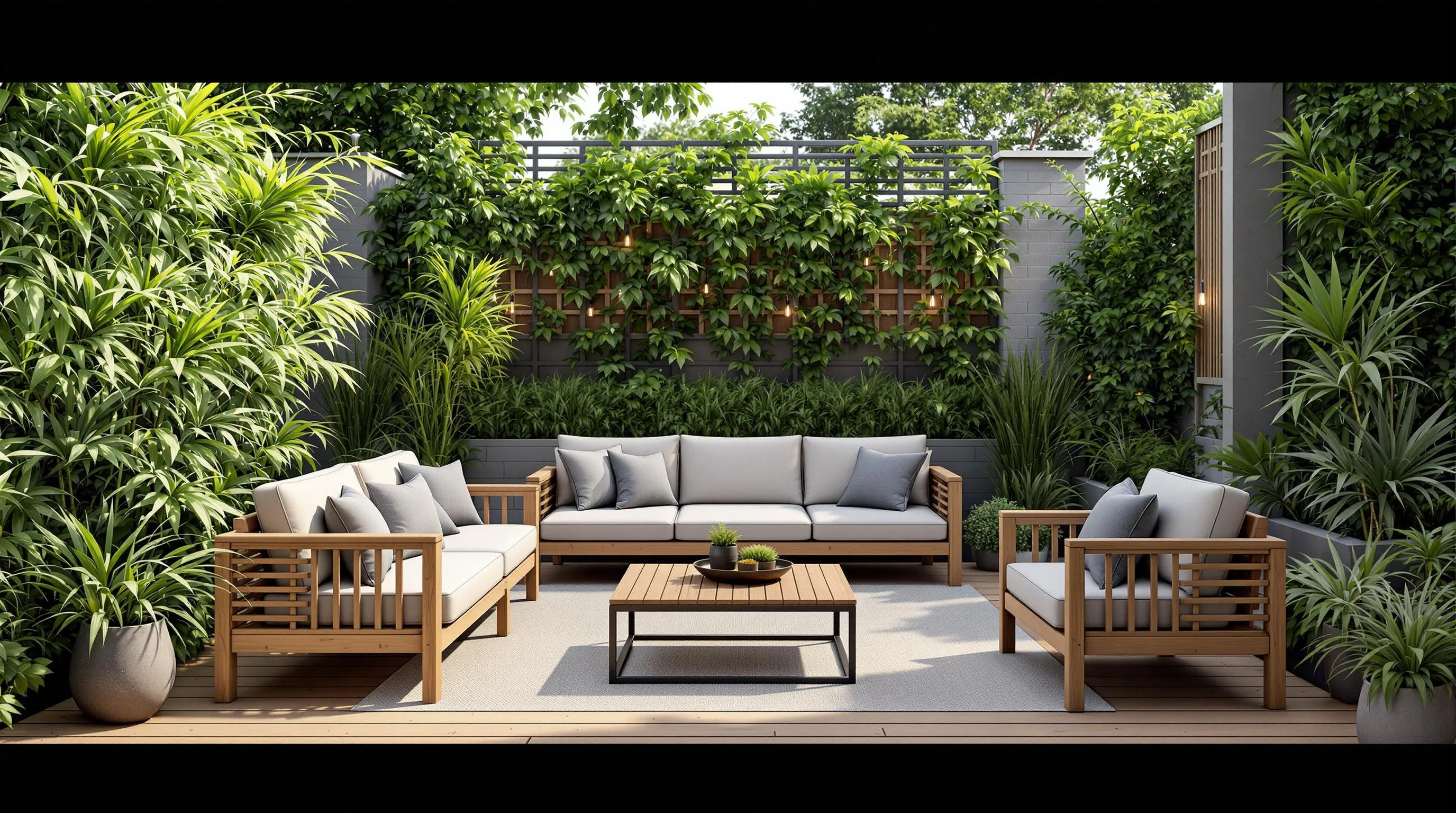
Transform your terrace into an inviting outdoor living room where you can relax surrounded by greenery. Creating a harmonious balance between comfortable seating and lush plants makes your terrace not just a garden but a true extension of your home.
Weather-Resistant Furniture Options
Select furniture that can withstand the elements while maintaining style and comfort. Teak and cedar pieces naturally resist moisture and insects, making them excellent long-term investments for your terrace lounge. Powder-coated aluminum furniture offers lightweight durability with rust-resistant properties, perfect for easily rearranging your space. Polyethylene wicker furniture provides the classic look of natural wicker but with superior weather resistance and UV protection. For cushions and fabrics, choose Sunbrella or other outdoor-exact textiles that repel water, resist fading, and dry quickly after rain. Modular furniture sets allow you to customize your seating arrangement based on available space and social needs, creating different configurations for intimate gatherings or larger parties.
Creating Privacy with Strategic Plant Placement
Create a secluded retreat by positioning tall potted plants like bamboo or ornamental grasses around your seating area to form natural privacy screens. Trellises covered with climbing vines such as jasmine or ivy can establish green walls that block neighboring views while adding fragrance and texture. Layer plants of varying heights around your lounge area—place taller specimens at the perimeter and gradually decrease heights as you move inward. This tiered approach not only provides privacy but creates an immersive, cocoon-like feeling. Consider movable planters with casters for flexible privacy answers that can be adjusted based on sun position or exact privacy needs. Dwarf trees in large containers, such as Japanese maples or citrus trees, offer height for screening while doubling as stunning focal points that anchor your lounge space.
Installing a Terrace Water Feature for Tranquility
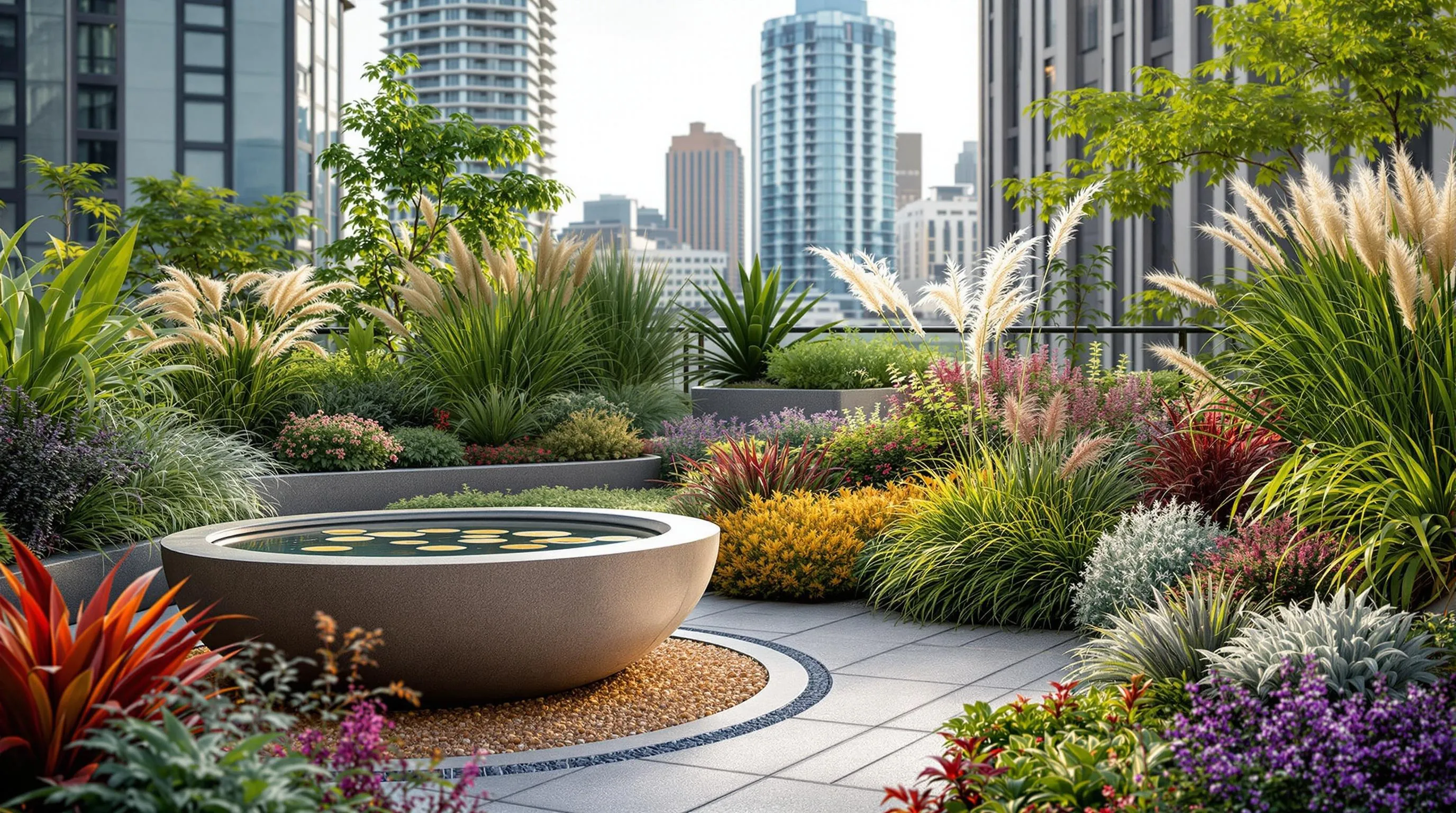
Adding a water feature to your terrace garden creates an instant sense of tranquility while improving the overall ambiance of your outdoor space. The gentle sound of flowing water masks urban noise and adds a sensory dimension that plants alone cannot provide.
Low-Maintenance Water Feature Ideas
Self-contained water bowls offer the simplest solution for terrace gardens, requiring minimal setup and maintenance. These compact features only need occasional water top-offs and can be placed anywhere without plumbing connections. Wall fountains maximize vertical space while creating a striking focal point, with many modern designs featuring recirculating pumps that conserve water. For truly hassle-free options, solar-powered floating fountains eliminate the need for electrical outlets and work in any existing container that holds water. Tabletop fountains provide another space-saving alternative, perfect for small terraces where every square inch counts. These compact designs create the soothing sound of trickling water without dominating your limited floor space.
Combining Water Elements with Plant Life
Integrate aquatic plants like water lilies or floating hyacinths into larger water features to create a natural network that requires less cleaning and maintenance. Edge your fountain or water bowl with moisture-loving plants such as Japanese iris, papyrus, or ornamental grasses to create a seamless transition between water and greenery. Consider installing a small bubbling rock fountain surrounded by lush ferns and mosses for a woodland-inspired corner that thrives in partial shade. For contemporary terraces, combine sleek water channels with strategically placed container plants to create architectural interest while maintaining clean lines. These water-plant combinations not only look stunning but also create beneficial microclimates that increase humidity for neighboring plants, helping your entire terrace garden thrive even during dry periods.
Adding String Lights and Lanterns for Evening Ambiance
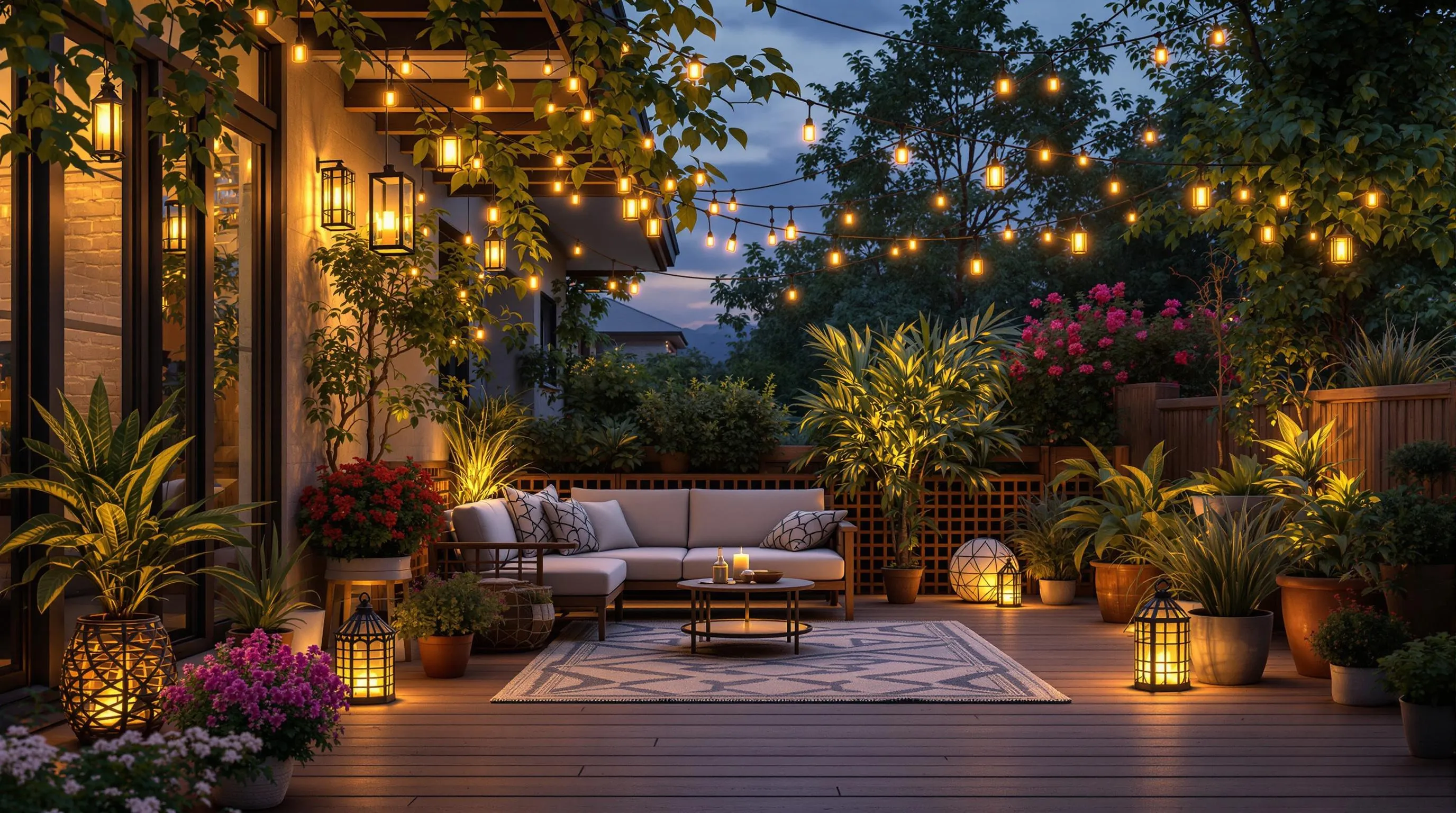
Transform your terrace garden into a magical nighttime retreat with the right lighting elements. Strategic illumination not only extends your enjoyment of the space into evening hours but also creates a captivating atmosphere that enhances your outdoor experience.
Solar-Powered Lighting Answers
Solar-powered lights offer an eco-friendly and cost-effective way to illuminate your terrace garden without increasing your electricity bill. These sustainable fixtures charge during daylight hours and automatically activate at dusk, providing hassle-free illumination. Consider solar string lights draped along railings or overhead for a starry effect, or stake lights to highlight pathways through your container arrangements. Solar lanterns come in various decorative styles—from Moroccan-inspired designs to minimalist globe shapes—and can be placed on tables or hung from hooks. For consistent lighting even after cloudy days, look for solar options with backup battery features. The latest solar technology provides warmer light tones rather than the harsh blue-white of earlier models, creating a more inviting ambiance for evening gatherings among your plants.
Creative Light Placement for Maximum Effect
Strategically position your lighting to accentuate your terrace garden’s best features while creating depth and dimension. Layer different types of lights at various heights—string lights overhead, lanterns at mid-level, and path lights at ground level—to create a three-dimensional lighting industry. Highlight architectural elements like trellises or water features with spotlights, and illuminate special plants from below to create dramatic shadows on nearby walls. Wrap fairy lights around potted trees or thread them through climbing plants for a magical effect. Place lanterns in clusters of odd numbers for visual interest, and use them to define gathering spaces or reading nooks. For dinner areas, suspend pendant lights or lanterns directly above tables to create intimate dining zones. Remember to create contrast—dark spaces between lit areas actually enhance the overall ambiance by preventing a flat, over-illuminated appearance that can feel harsh and unnatural.
Establishing a Terrace Herb and Vegetable Garden
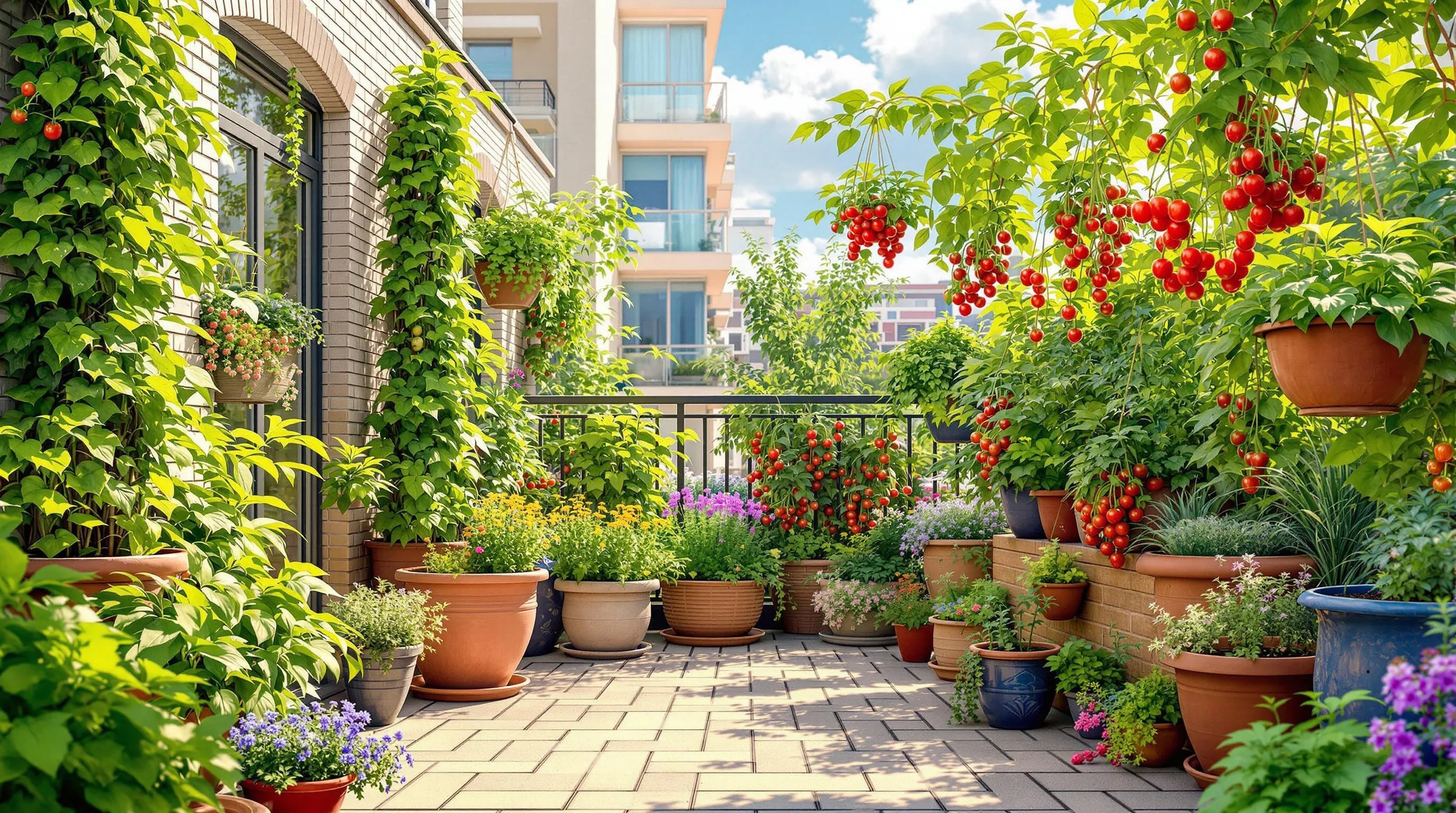
Transform your terrace into a productive food garden that’s both beautiful and functional. Growing your own herbs and vegetables not only provides fresh, organic produce right outside your door but also adds vibrant colors and textures to your outdoor space.
Best Edible Plants for Terrace Gardens
Herbs thrive exceptionally well in terrace environments and require minimal space. Plant culinary favorites like basil, thyme, rosemary, and mint in small containers where they’ll flourish with good drainage and sunshine. Leafy greens such as lettuce, spinach, and kale are perfect terrace vegetables that grow quickly and can be harvested multiple times from the same plant. Cherry tomatoes and determinate tomato varieties perform beautifully in large pots or hanging baskets, providing visual interest with their red fruits. Consider compact vegetable varieties bred specifically for containers, like bush cucumbers, fingerling eggplants, and mini bell peppers. Strawberries make excellent additions to hanging planters or vertical systems, cascading attractively while producing sweet treats. For year-round harvests, incorporate perennial edibles like chives, oregano, and alpine strawberries that return season after season with minimal care.
Space-Efficient Gardening Techniques
Vertical growing systems maximize your harvest potential in limited terrace space. Install wall-mounted planters or trellises for climbing plants like peas, beans, and cucumbers to grow upward rather than outward. Carry out square foot gardening by dividing growing areas into 1’×1′ squares, allowing you to plant different crops in each section based on their spacing needs. Try tower gardens or tiered planters that stack multiple growing levels vertically, dramatically increasing your planting capacity without expanding your footprint. Use hanging baskets for trailing herbs and vegetables, keeping them accessible while freeing up valuable floor space. Embrace companion planting by combining plants that benefit each other, such as basil with tomatoes or carrots with rosemary, to maximize yield and naturally deter pests. Incorporate self-watering containers that maintain consistent moisture levels and reduce maintenance time, perfect for busy urban gardeners who can’t water daily.
Implementing a Shade Strategy for Hot Terrace Spaces
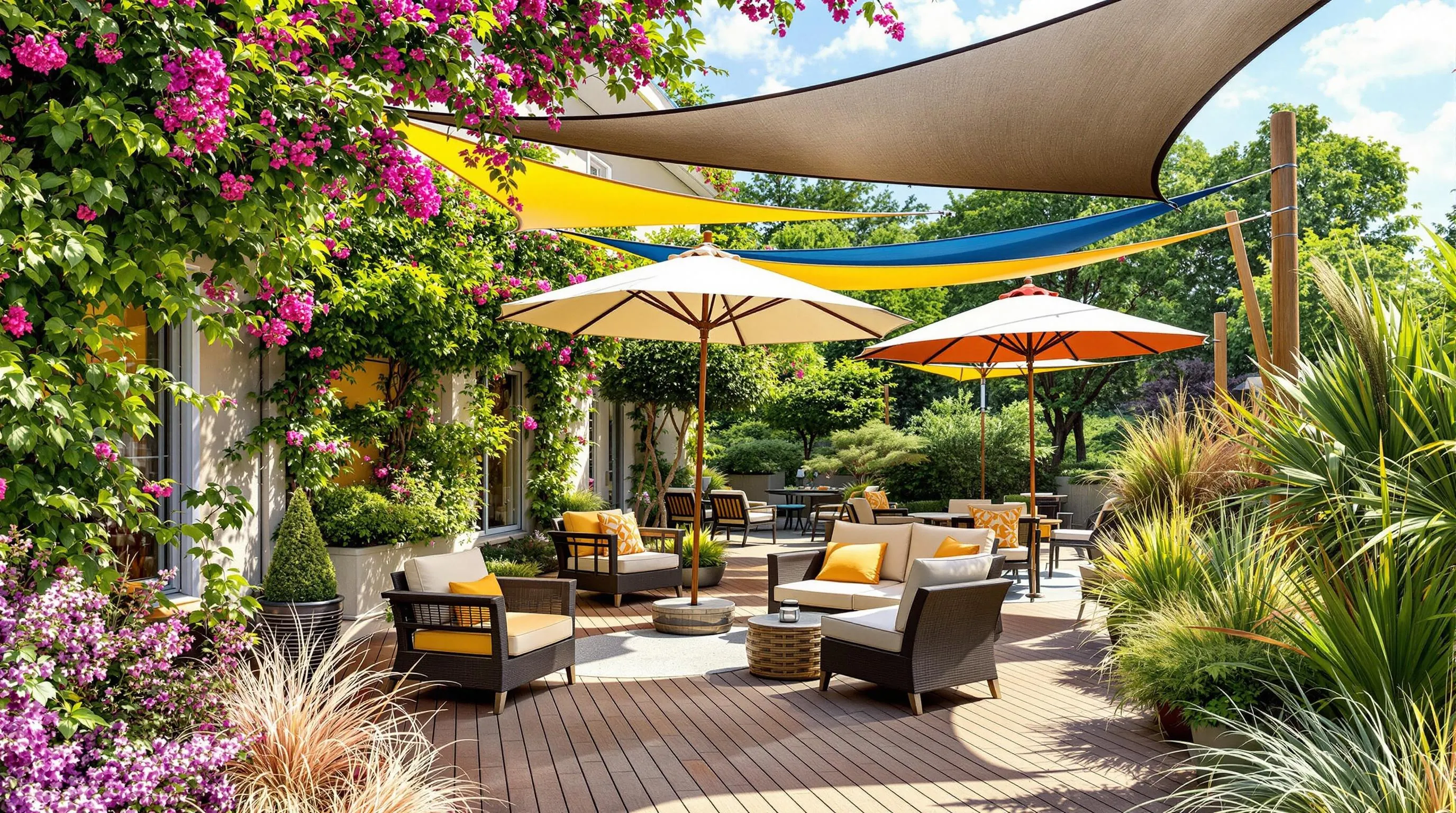
Creating a comfortable outdoor experience on your terrace means addressing intense sun exposure. Without proper shade, even the most beautiful terrace garden can become unusable during hot summer days. Implementing strategic shade answers allows you to enjoy your outdoor space throughout the day while protecting both you and your plants from harsh sunlight.
Plant-Based Shade Answers
Natural shade from plants offers a sustainable, beautiful way to cool your terrace. Fast-growing climbing plants like jasmine, wisteria, or morning glory can transform pergolas and trellises into living shade structures within a single growing season. Position tall potted trees such as Japanese maples or dwarf citrus strategically to cast shadows over seating areas during peak sun hours. For immediate impact, bamboo provides excellent screening while creating a cooling effect through transpiration. Create a green canopy by training vines across wire cables suspended above your terrace, allowing dappled light to filter through while blocking direct sun. Tall ornamental grasses like miscanthus or pennisetum planted in large containers can provide movable shade screens that sway gracefully in the breeze, adding both function and movement to your terrace garden.
Stylish Canopy and Umbrella Options
Modern shade structures combine protection with aesthetic appeal for your terrace garden. Retractable awnings offer flexible coverage that can be extended during intense sunshine and retracted to enjoy pleasant evening skies. Cantilever umbrellas provide wide coverage without a central pole obstructing your space, perfect for positioning over dining areas or lounge seating. Sail shades in weather-resistant fabrics create architectural interest while blocking up to 95% of harmful UV rays, available in various colors to complement your garden design. For a permanent solution, pergolas fitted with adjustable louvers allow you to control light levels throughout the day. Portable umbrella stands with wheels let you follow the sun’s movement, providing targeted shade exactly where needed as the day progresses. These structured shade options can transform an otherwise unusable hot terrace into a comfortable retreat during even the warmest summer days.
Creating a Terrace Zen Garden for Urban Relaxation
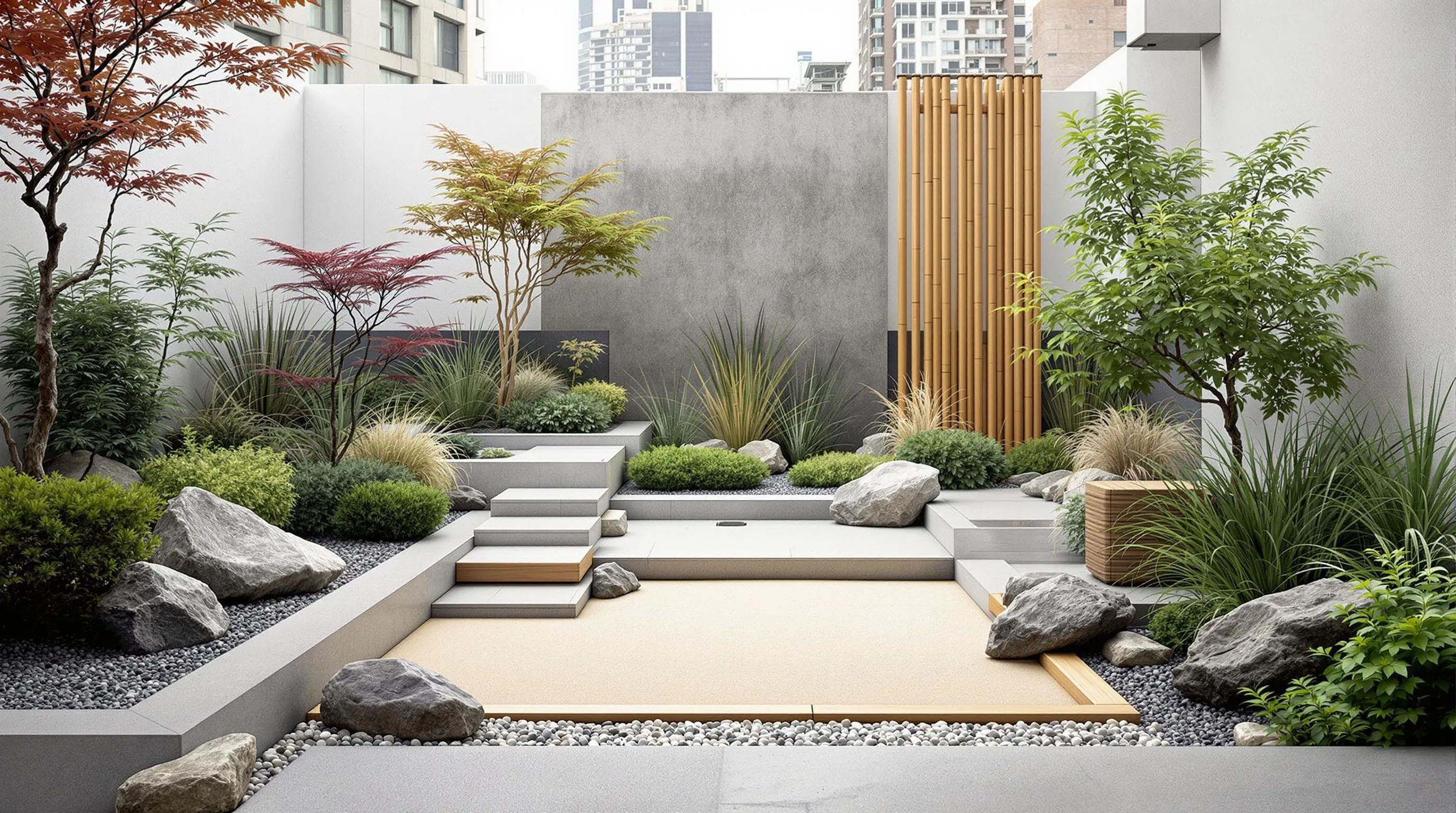
Transform your terrace into a peaceful sanctuary with a Zen garden design that counterbalances the chaos of city living. A terrace Zen garden draws on Japanese principles of minimalism and natural harmony to create a space dedicated to meditation and relaxation.
Minimalist Planting Approaches
Embrace the “less is more” philosophy in your terrace Zen garden with carefully selected plants that promote tranquility. Choose just 3-5 specimen plants like Japanese maples, cloud-pruned junipers, or ornamental grasses that make bold statements through their form rather than quantity. Arrange these focal plants asymmetrically to create visual interest while maintaining open space, which is crucial in Zen design. Opt for a monochromatic color palette featuring various shades of green to foster a sense of calm, occasionally punctuated with subtle seasonal blooms from azaleas or camellias. Container selection should follow clean lines and neutral tones—matte black, natural stone, or unglazed clay pots work perfectly to showcase your minimalist plant collection without competing for attention.
Incorporating Stone and Sand Elements
Stone and sand form the foundation of authentic Zen gardens, bringing natural elements to your urban terrace. Add a small bed of fine white gravel or sand (4-6 inches deep) contained in a low, square wooden frame where you can create traditional rake patterns that symbolize water ripples—a meditative practice itself. Position 3-5 weathered stones of varying sizes and shapes across this sand bed, following the Japanese concept of grouping odd numbers for natural balance. For terraces with weight restrictions, use lightweight lava rocks or hollow ceramic stones that mimic natural formations. Incorporate a water element through a small bamboo fountain or a simple stone basin (tsukubai) that creates gentle sounds to mask urban noise. These stone and sand features don’t require much space—even a 3×3 foot area can create an impactful Zen focal point that grounds your terrace garden in tranquility while providing a visual anchor for meditation and reflection.
Using Smart Irrigation Systems for Low-Maintenance Care
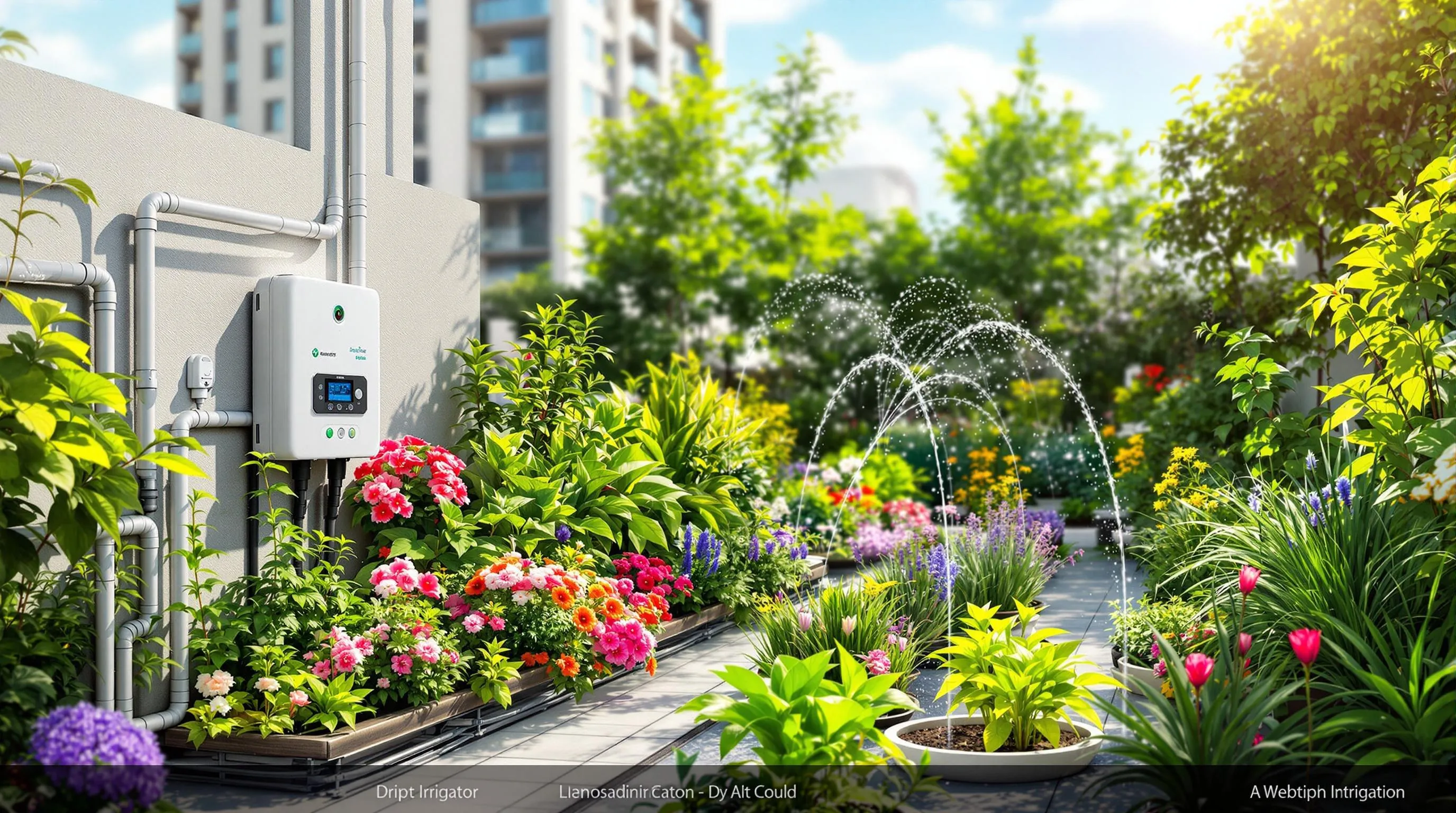
Smart irrigation systems can transform your terrace garden into a self-sustaining oasis while conserving water and saving you precious time. These innovative answers deliver precisely the right amount of moisture directly to your plants’ roots, eliminating wasteful overwatering and reducing your maintenance workload significantly.
Water-Saving Irrigation Technologies
Drip irrigation systems stand out as the most efficient water-saving technology for terrace gardens, delivering water directly to plant roots at 90% efficiency compared to conventional sprinklers’ 50-70%. Micro-sprinklers offer another excellent option, creating a gentle mist that covers small areas without water loss from wind drift. Smart controllers with soil moisture sensors automatically adjust watering based on real-time conditions, reducing water usage by 20-50% annually. Rain barrels and water collection systems can be integrated with smart irrigation, allowing you to harvest rainwater from your roof and redirect it to your terrace plants through automated systems. For container-heavy gardens, self-watering planters with water reservoirs provide consistent moisture through capillary action, keeping plants hydrated for up to two weeks between refills.
Automated Watering Schedules for Busy Gardeners
Set-and-forget timers let you program precise watering schedules aligned with each plant’s needs and your local climate conditions. Wi-Fi enabled controllers offer remote management through smartphone apps, allowing you to adjust watering from anywhere when weather changes unexpectedly. Zone-based systems treat different areas of your terrace garden individually, delivering the perfect amount of water to sun-loving plants, shade dwellers, and thirsty vegetables separately. Many smart systems now incorporate weather forecasting data, automatically skipping scheduled watering when rain is predicted or adjusting for extreme heat. For ultimate convenience, look for systems with voice assistant compatibility that let you control irrigation through simple commands to Alexa or Google Home, making terrace garden maintenance virtually effortless even during your busiest weeks.
Seasonal Planning for Year-Round Terrace Garden Beauty
Your terrace garden can be a vibrant living space throughout the entire year with thoughtful seasonal planning. By selecting plants that shine in different seasons you’ll enjoy continuous beauty regardless of the calendar.
Consider creating a planting schedule that transitions smoothly from spring bulbs to summer flowering plants followed by fall foliage and winter-interest specimens. This approach ensures your outdoor sanctuary never loses its appeal.
Remember that each season offers unique opportunities for your terrace garden. Whether it’s refreshing spring arrangements dramatic summer blooms rich autumn colors or structural winter elements your terrace can always serve as your personal retreat from urban life.
With the ideas shared in this guide you’re well equipped to transform your terrace into an enchanting garden that evolves and thrives year-round.





